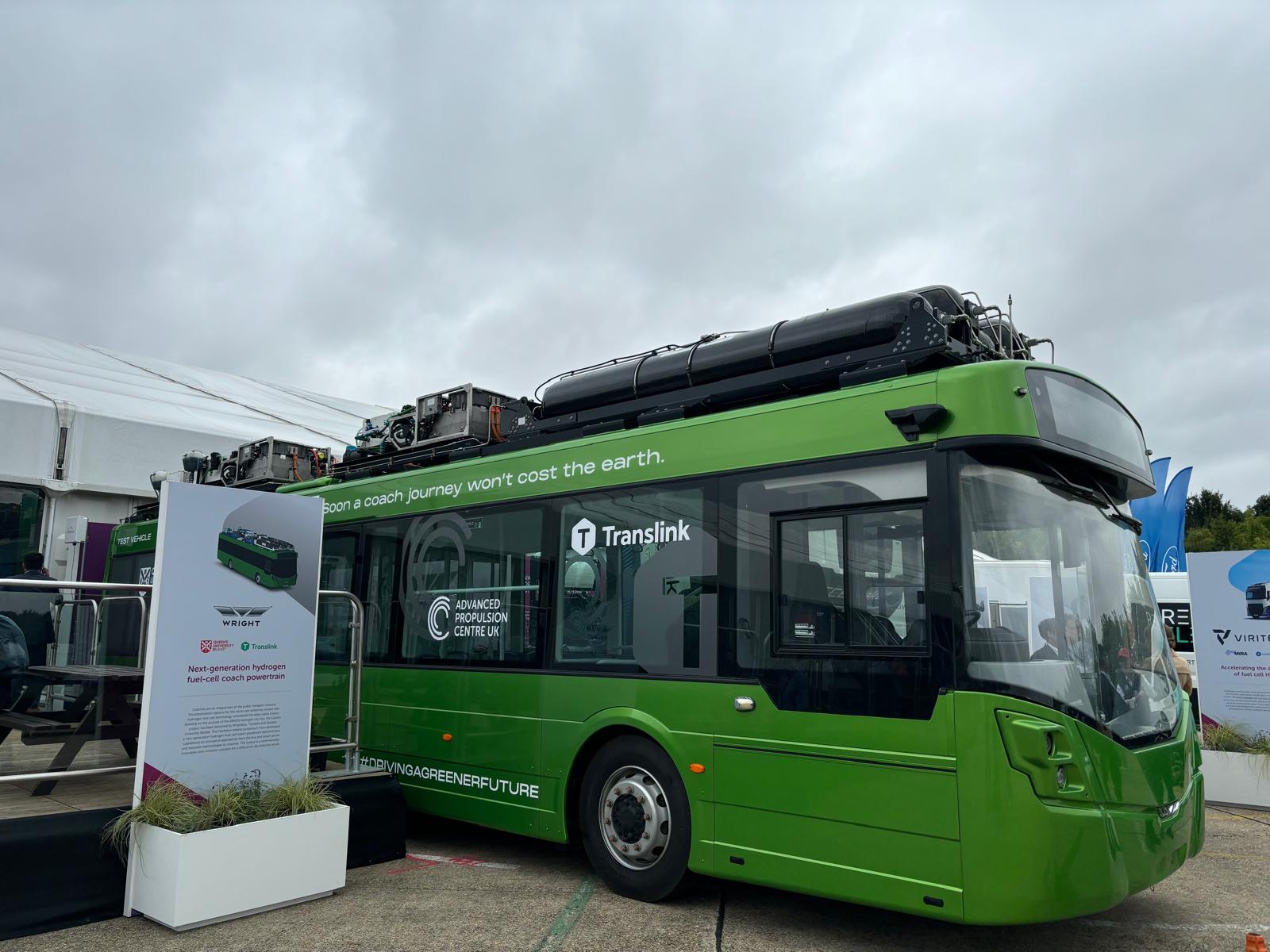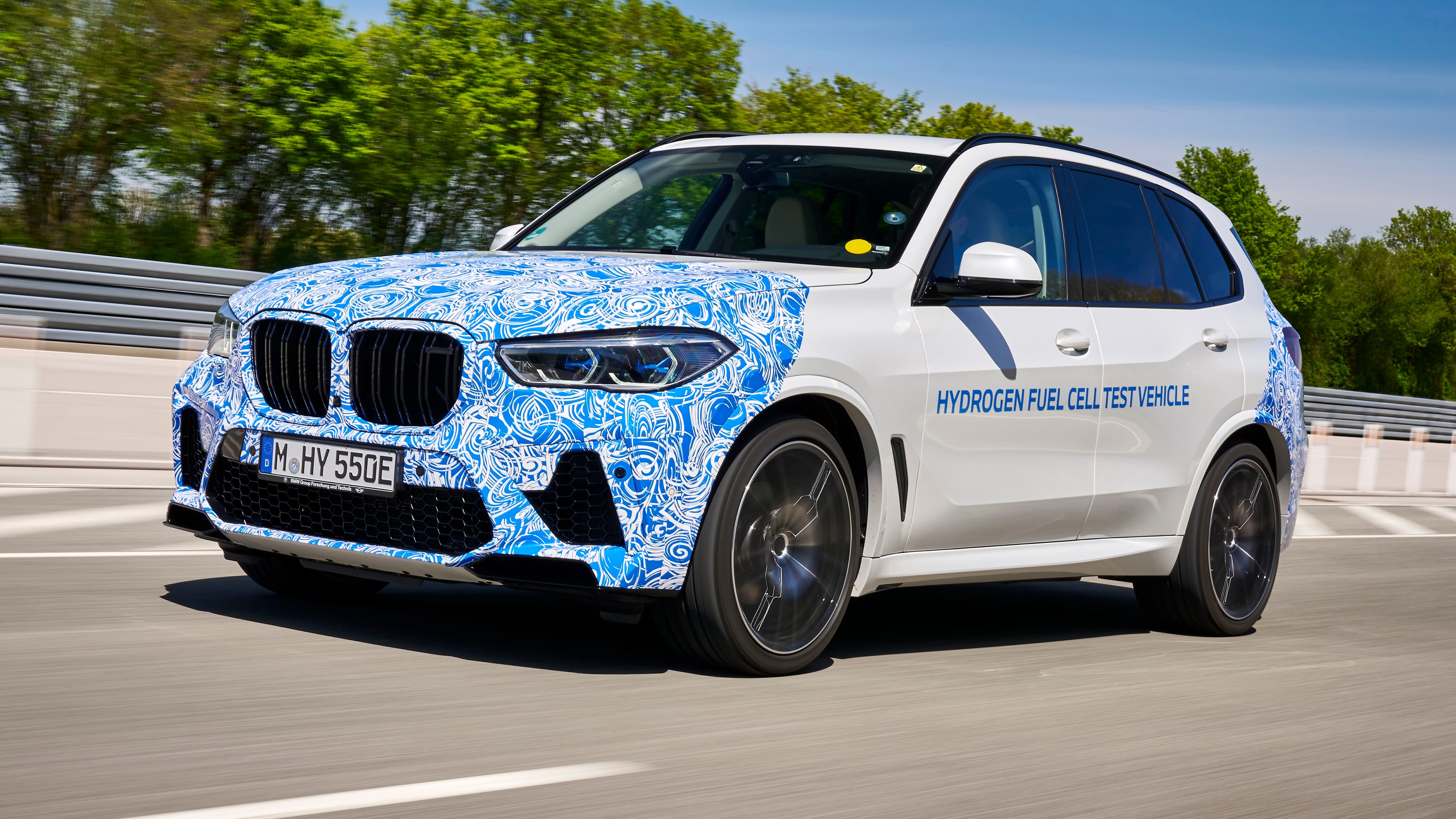The concrete test track at UTAC in Bedfordshire cuts a circular swathe through verdant countryside. It is usually a venue for high-performance cars being put through their paces, but last week it hosted a more sedate form of transport: a prototype coach powered by hydrogen.
Belfast-based Wrightbus, owned by Jo Bamford, scion of the construction-equipment giant JCB, was at the Cenex Expo to show off a bus with hydrogen gas tanks, and fuel cells on the roof. Wrightbus has already sold about 300 hydrogen buses, which are in use in major cities including London.
But coaches are a step up, explained Robert Best, head of engineering. “Existing hydrogen vehicles are good at medium and slow speed, but they’re not very good at high speed,” he said. “This is looking at how you can do a high-speed hydrogen powertrain that can cope with long distances.”

Hydrogen has been described as the “Swiss army knife of decarbonisation” by Bill Gates, the Microsoft founder and, now, an environmental activist and investor. Its main attraction is that, when burnt, it emits no carbon dioxide. It is used to make petrochemicals, ammonia, methanol and steel, but in recent years the gas has been touted as a means of stripping emissions from cars, houses, ships and even planes.
That hype has cooled. In recent months, a number of companies have cut back or ditched hydrogen-related investment. And just 4 per cent of hydrogen projects globally have received final investment decisions to proceed, according to the International Energy Agency. Has this Swiss army knife been blunted before it can make its mark?
One of the primary obstacles to hydrogen take-up is the need to create it — and lots of it. Despite being one of the most abundant elements in the universe, hydrogen is usually found bundled with other molecules. To get it, you have to split it — and this requires energy.
The cost of using energy to make energy is perhaps the biggest reason why critics of hydrogen doubt it will catch on.
‘Inefficient’ energy
“It’s not just expensive to make clean hydrogen — it’s expensive to transport it, store it and distribute it,” said Michael Liebreich, an energy consultant to industry and the government.
Most hydrogen used today is called “grey” hydrogen, and comes from burning fossil fuels such as natural gas. The industry is exploring the production of “blue” hydrogen, which is also made from fossil fuels but with the resulting carbon dioxide being squirrelled away into caverns.
The cleanest form is “green” hydrogen. This is made by plumbing renewable energy into a device called an electrolyser, which runs an electrical charge through water and splits it into hydrogen and oxygen molecules.
Critics of hydrogen, however, question whether this is the best use of renewable energy. Liebreich said: “If you’ve got green electricity, and if you believe we’ve got a climate crisis, then the last thing you should do is chuck a whole bunch of it away making hydrogen, because it’s a very inefficient process end to end.”
Robert Howarth, professor of ecology at Cornell University in New York, concurred. “In most cases, it is more efficient to use renewable electricity directly rather than to produce hydrogen and then use the hydrogen as a fuel,” he said. “Hydrogen has been wildly over-hyped as a fuel source.”
Champions of the gas retort that it is the perfect way to capture excess energy from wind farms and solar panels when demand is low. Instead of paying for wind turbines to be switched off at these times, as we do now, simply plug that energy into an electrolyser, brew up some hydrogen, and store it in a tank until it is needed. Hydrogen becomes a big battery.
To do this, however, you need lots and lots of electrolysers — and there are doubts that the sector can supply the quantities needed. About 1 per cent of hydrogen produced today is of the clean, green variety, according to the International Renewable Energy Agency.
“It’s not moving quickly enough. But more industries are now talking about green hydrogen,” said Dr Sudhagar Pitchaimuthu, associate professor in engineering and physical sciences at Heriot-Watt University in Edinburgh. In the EU, at least, those industries have been spurred by a directive that will force them to curb their emissions.
Pitchaimuthu is part of a team looking at ways to bring down the cost of electrolysers by replacing the expensive rare minerals they use with other, more abundant materials.
A further challenge is the amount of water needed by electrolysers. “If you want to produce 1 kilogram of hydrogen, it requires 9 to 14 kilograms of water. So if you want to produce a million tonnes of hydrogen, think about the amount of water you will require,” said Pitchaimuthu. Scientists are getting creative: earlier this year, his team unveiled research into using waste water from whisky distilling.
Expanding interest
Given the odds that are stacked against green hydrogen, its champions could be forgiven for feeling despondent. But that is not the case, according to Chester Lewis, head of sourcing at hydrogen supplier Ryze, which is also backed by Bamford. “There’s been a bit of a lull in new projects coming to the market. But we’re starting to see bigger projects come through,” he said.
While a number of companies have cut back on hydrogen-based initiatives this year — among them, the Danish energy giant Orsted and the Australian miner Fortescue — others have committed themselves to bringing projects on stream. These include Shell, which approved a project in Germany in July, and TotalEnergies of France, which in the same month bought half an offshore wind farm with a view to using it for hydrogen production.
“The hype has certainly come off, particularly in the last two years. But I think the downfall of hydrogen has been quite exaggerated,” said Lacie Midgley, an analyst at stockbroker Panmure Liberum.
JJ Traynor, managing partner at HydrogenOne, a listed fund that invests in the sector, added: “Hydrogen is actually accelerating pretty quickly.” He pointed to data showing that investments in the technology had risen by a quarter so far this year.
The government has played a part in awarding contracts to hydrogen suppliers that guarantee a certain price for their product over 15 years. The contracts for the first round of projects were announced last year, with a second round due soon. The hope is that by providing clarity on the price that suppliers will receive, the initiative will provide incentives for production in a similar way to government schemes that spurred the development of wind and solar power.
For Eugene McKenna, commercial and strategy director for hydrogen at the sustainable technology company Johnson Matthey, prices have to come down for end users before green hydrogen will truly take off.
“A lot of businesses have stepped up to the plate and invested, and we are ready to manufacture [hydrogen],” he said. “The problem is the demand for the hydrogen, which isn’t coming forward as quickly as it should be. You need the appropriate price for the end material. But as demand picks up, we’re now in a very good position to supply it.”
Hitting the road
Almost a decade after Toyota unveiled the hydrogen-powered Mirai car, the transport sector is embracing the gas. Last week, BMW announced its first hydrogen fuel-cell car, which will make its debut in 2028, and the Vauxhall owner Stellantis will this month unveil a medium-sized hydrogen van.

At Cenex in Bedfordshire, attendees listening on headphones were treated to two days of back-to-back seminars from hydrogen specialists on the opportunities and pitfalls of the gas in transport.
Sitting on board Wrightbus’s experimental coach was Ian Constance, chief executive of the Advanced Propulsion Centre, a government-backed body that helped fund the work. He insisted hydrogen transport would be part of the decarbonisation mix alongside battery electric vehicles. “This isn’t about battery versus hydrogen,” he said. But he added that hydrogen was useful for larger vehicles because it weighed less than batteries and refuelling could be done quickly.
Hydrogen infrastructure lags far behind that of electric cars, with just six publicly available filling stations in the UK. But Constance said: “There have been studies saying that you don’t need that many to strategically cover most of the country. It can be done. But we need to see from government a co-ordinated approach to energy supplies.”
The UK, he added, was one of the world leaders in hydrogen technology. “That won’t persist unless we continue to support it.”
